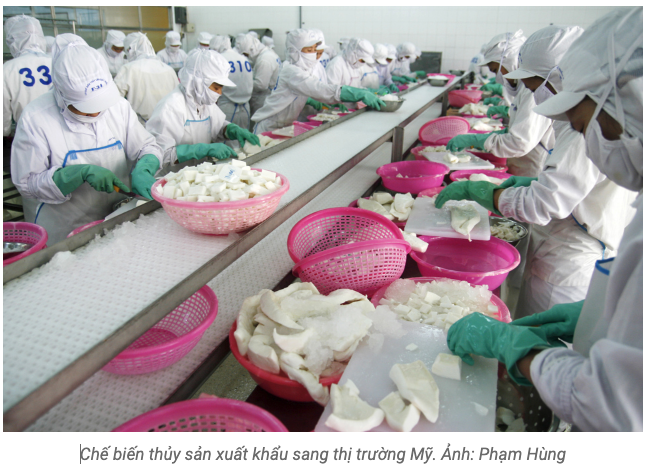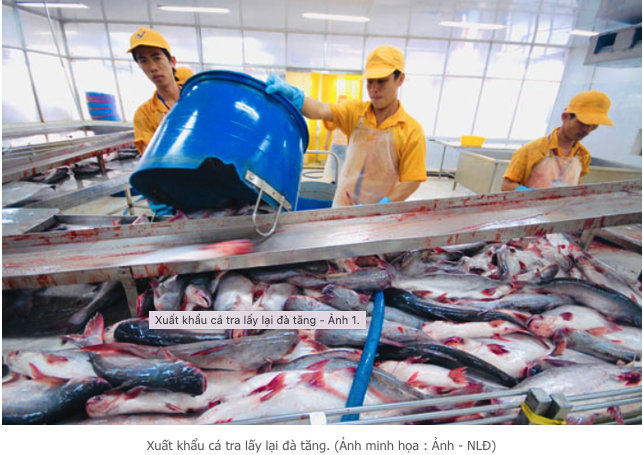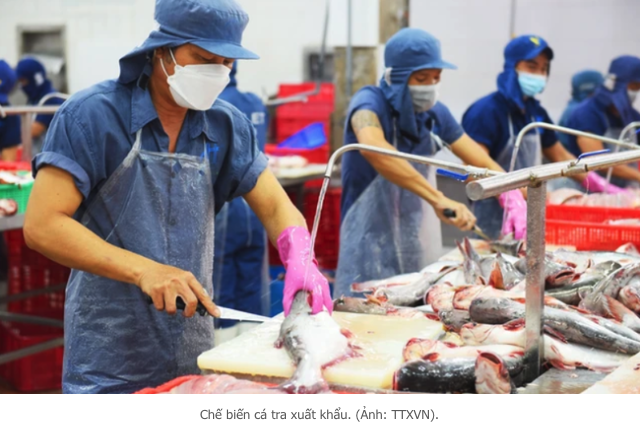In the first 10 months of 2023, our country achieved a record export surplus of $24.59 billion USD, 2.6 times higher than the surplus of $9.56 billion USD in the same period last year. The latest preliminary statistics from the General Department of Customs recorded the total import-export turnover in the second half of October (16th to 31st) at $34.51 billion USD, a 27.7% increase (equivalent to an increase of $7.49 billion USD) compared to the first half of October 2023.
The results achieved in the latter half of October brought the total import-export turnover of the entire country in 10 months to $558.33 billion USD, a decrease of 9.6% (equivalent to a decrease of $59.11 billion USD) compared to the same period last year.
In October’s second half, exports reached $18.02 billion USD, a 27% increase (equivalent to an increase of $3.83 billion USD) compared to the first half of October 2023. Strongly increasing groups of goods include: Machinery, equipment, tools, and spare parts; computers, electronic products, and components; various types of footwear; textile and garment products; transportation means and spare parts; various types of iron and steel…”
At the end of October, the total import turnover of the country reached $266.87 billion USD, a decrease of 12.2% (equivalent to a decrease of $37.07 billion USD) compared to the same period in 2022.
In October, the trade balance of goods had a surplus of $1.52 billion USD. Thus, in the first 10 months, Vietnam achieved a trade surplus of $24.59 billion USD, 2.6 times higher than the surplus of $9.56 billion USD in the same period last year.
The Ministry of Industry and Trade assessed that businesses have performed well in expanding and diversifying markets. While exports to major markets such as the US and the EU have decreased, exports to African, Eastern European, Northern European, and Western Asian countries continue to increase.
Mr. Do Ngoc Hung, Commercial Counsellor, Head of the Vietnam Trade Office in the US, stated that the US Department of Agriculture is planning to purchase a large quantity of frozen pangasius fillets for domestic food distribution programs. On August 31st, the US Department of Commerce issued preliminary conclusions from the 19th review of Vietnam’s frozen pangasius fillet, determining a significant reduction in anti-dumping tariffs compared to the previous review. The US Department of Agriculture has also conducted inspections on Vietnam’s food safety control system for pangasius with positive results, noting only minor non-systemic errors. These are positive signals for the prospect of pangasius exports to the US in the future.
On a broader scale, the global economic and trade situation continues to be complex and unpredictable. Global economic growth is slow to recover, carrying many risks. The risk of economic recession still looms, causing inflation and interest rates to remain high, leading to a sharp decline in consumer demand in many major export markets of Vietnam. However, the continued efforts of developed countries to diversify their supply sources will help Vietnam become an important production and export hub in the global value chain.
Given the aforementioned risks and challenges, it is imperative for ministries, sectors, localities, and especially the business community not to be negligent or subjective. Close monitoring of supply-demand dynamics and commodity prices globally and domestically is necessary to be ready with timely plans and solutions, striving to achieve the set export growth targets. To support exports, the Ministry of Industry and Trade has announced plans to enhance export promotion strategies to major recovering markets such as the US and China.
Consequently, the Ministry is directing relevant parties to enhance the efficiency and regulation of customs clearance for import-export goods at border gate areas between Vietnam and China. Additionally, it is coordinating with the Ministry of Agriculture and Rural Development to negotiate with China to open up more export markets for other Vietnamese fruits and vegetables such as pomelo, fresh coconut, avocado, pineapple, star apple, lime, and honeydew.
Moreover, the ministry continues to focus on supporting businesses to leverage commitments within free trade agreements to boost exports. Simultaneously, it aims to expedite the completion and implementation of new trade agreements with partners holding significant potential to diversify markets, products, and supply chains.
https://congthuong.vn/can-can-thuong-mai-tiep-tuc-xuat-sieu-ky-luc-voi-2459-ty-usd-285381.html
Trade promotion has shown signs of improvement in the last months of the year.
Many key export items of Vietnam have recorded positive growth in the past 10 months, indicating positive signals from export markets. To achieve the 6% export growth target in 2023, the Ministry of Industry and Trade and businesses need to focus on penetrating new markets.

Several Key Export Items Have Grown
Information from the Import and Export Department (Ministry of Industry and Trade) indicates a resurgence in the country’s goods export turnover in October 2023, estimated at $32.3 billion USD, a 5.3% increase compared to September 2023. Consequently, the total goods export turnover for the first 10 months of 2023 is estimated at $291.2 billion USD, only a 7.1% decrease compared to the same period in 2022.
Notably, in the past 10 months, there have been five items with export turnover exceeding $10 billion USD in the processing industry group: various types of phones and components reaching $44.02 billion USD; other machinery, equipment, tools, and spare parts reaching $35.51 billion USD; textiles reaching $27.8 billion USD; footwear reaching $16.05 billion USD; wood and wooden products reaching $10.8 billion USD.
A bright spot in Vietnam’s export landscape is the agricultural product group, with an export turnover reaching $26.7 billion USD, a 3.8% growth in the past 10 months. Notably, several items have shown impressive growth, such as vegetables reaching $4.9 billion USD, a 78.9% increase compared to the same period in 2022. Following that is the rice export with a volume of 7.1 million tons, reaching $3.97 billion USD, a 34.9% increase compared to the same period in 2022.
Assessing the export situation, Deputy Director of the Import and Export Department (Ministry of Industry and Trade), Tran Thanh Hai, notes that Vietnam’s high economic openness makes it significantly affected by global economic changes. Most noticeable is the reduction in spending by major economies, Vietnam’s export partners such as the US and the EU, on ordinary and luxury goods, leading to decreased order volumes.
“Export activities in the last two months of the year will continue to flourish as inflation in major economies like the US, Europe tends to cool down, and inventories in countries are gradually decreasing. Simultaneously, the demand for goods consumption also increases during the year-end holidays, signaling positive prospects for Vietnamese export enterprises,” forecasted Mr. Tran Thanh Hai.
Many economic experts believe that export markets, especially the EU, impose increasingly stringent requirements on imported goods, especially agricultural products. Some key export industries of Vietnam, such as seafood, wood and wooden products, iron and steel, and plastic products, still face pressures related to trade defense investigations.
Rice export in the first 10 months of 2023 reached 7.1 million tons, achieving nearly $4 billion USD.
Catfish Export Picks Up Momentum
According to the Vietnam Association of Seafood Exporters and Producers (VASEP), catfish exports are currently showing a positive growth rate of 9% compared to the same period last year.
As of the end of October, the export turnover of this commodity has reached over 1.5 billion USD. To prepare for the end-of-year holiday season, the two main markets, the United States and China, are starting to increase their demand.

Regarding the Chinese market, due to geographical advantages, our country’s catfish products can compete better, especially in the fresh and frozen seafood segments for domestic consumption in this populous market.
Expectations for Catfish Exports by Year-End
Not only traditional markets but countries participating in the Comprehensive and Progressive Agreement for Trans-Pacific Partnership (CPTPP) are also rebounding. Although catfish exports have not yet completely overcome all difficulties, this is also a sign of hope for the end-of-year months.
Although in early November, catfish export activities have somewhat slowed down, businesses and associations still anticipate market stability in the coming months.
Phan Hoang Duy, Deputy General Director of Can Tho Seafood Import-Export Company, stated, ‘We anticipate good news from the Chinese market from the end of November to December. And the second-largest market for Vietnamese catfish is the United States, where they have a special seafood consumption season, especially for catfish, usually from February to April each year, when importers will take advantage of this period for purchases. The company also hopes for changes in the market with positive developments.’
Dương Nghĩa Quốc, Chairman of the Vietnam Catfish Association, stated, ‘The remaining two months have seen increased orders in some markets, especially China and the US, compared to the previous quarter, which means negative growth is gradually decreasing. Positive signals are appearing for export markets at the end of this year and in the first quarter of 2024.’
Currently, catfish exports are improving in CPTPP markets. According to statistics from the Vietnam Catfish Association, many markets have achieved double-digit growth rates, such as Canada, Mexico, Japan, with growth ranging from 16% to 75%.
However, according to businesses, to open up markets and revitalize the catfish industry, multiple aspects need to be emphasized.
Ong Hang Van, Deputy General Director of Truong Giang Seafood Company, said, ‘In the CPTPP market, we need to strengthen marketing so that they have a better understanding of catfish. Another important aspect is that we must change the breeding methods of fish, use low-density farming, prevent diseases to make the fish grow rapidly, reduce the cost of catfish to compete with all other white-meat fish.’
Vietnamese catfish products are exported to over 150 global markets, with an export turnover of 2.44 billion USD in 2022. Focusing on improving the quality and value in the production chain of catfish products is expected to achieve the catfish industry’s export target of 2 billion USD this year.
Improving Production for Facilitating Pangasius Exports
Facing stringent market demands for food safety, quality, and competitive pricing, the pangasius industry is prioritizing numerous solutions to enhance the production chain – from cultivation to processing for export supply. This is an essential condition to leverage opportunities and optimize the export potential of the robust aquaculture industry in the region.
Despite possessing over 300 hectares of raw materials and investing in a feed processing plant with a capacity of 450 tons per day, Dai Thanh Aquaculture Company has suffered setbacks due to a significant decline in exports. In hopes of market recovery, the enterprise is concentrating efforts on cost reduction to lower export prices.
“Our leadership is determined to review all reduced costs to provide customers with both good prices and quality,” stated Hang Quoc Dinh, Head of Sales at Dai Thanh Aquaculture Company.

Statistics until the end of October indicate that there are over 5,300 hectares of newly cultivated pangasius in the Mekong Delta. This figure almost doubles compared to the newly cultivated area during the same period last year. With favorable export conditions, the cultivation area is expected to expand further. The demand for high-quality fingerlings that meet import standards is becoming a primary concern.
Duong Nghia Quoc, Chairman of the Vietnam Pangasius Association, mentioned, “We also propose that the Ministry of Agriculture and Rural Development guide specialized agencies such as the Fisheries Research Institute 2 to collaborate with the provincial Departments of Agriculture and Rural Development to ensure adequate resources for producing standardized fingerlings in the pangasius supply chain of the Mekong Delta.”
Import regulations for pangasius products increasingly demand adherence to high standards throughout the supply chain, from fingerlings to processing procedures, ensuring safety and quality. Access to good, disease-free fingerlings is crucial to enhancing investment efficiency. The competitive advantage in exporting pangasius will be further maximized.








